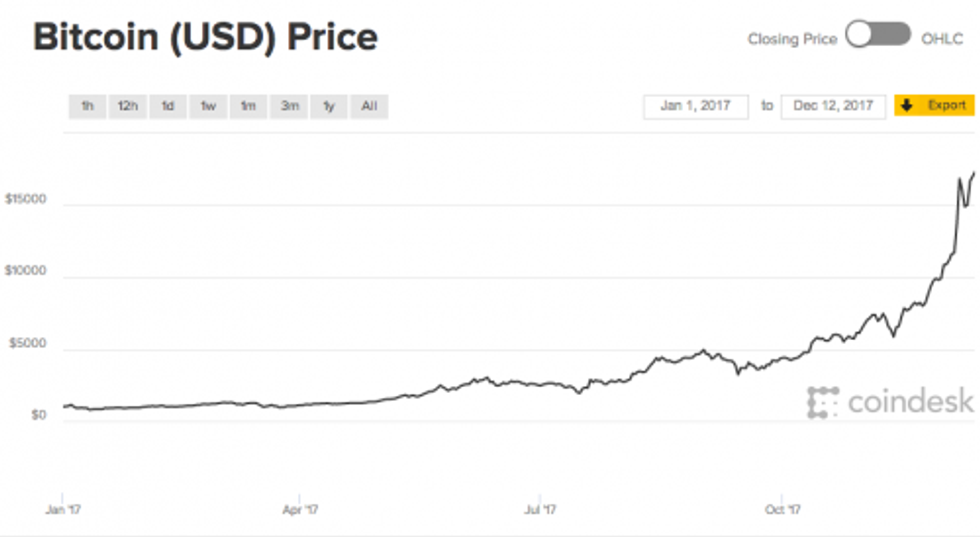Bitcoin Trends 2017: The Revolution Begins

It goes without saying that 2017 was the year of bitcoin. Here, the Investing News Network looks back to the year’s biggest trends as it relates to the cryptocurrency mammoth.
It’s been decided: 2017 was, without a doubt, the year of bitcoin–and overwhelmingly so.
At the end of 2016–on December 31–the digital currency mammoth closed the year at $968.23 per token and, since then, has continuously broke new records throughout the year. That said, despite the impressive year the cryptocurrency has had, many industry analysts and experts certainly didn’t project just how successful it would be in 2017.
With that in mind, here the Investing News Network (INN) provides a look back to bitcoin’s record year with insight and commentary from industry analysts as to what the year’s biggest bitcoin trends were.
Bitcoin trends 2017: soaring price
Of course, one of the biggest bitcoin trends of 2017–if not the biggest–is attributed to the fact that it continually broke record prices and crossed thresholds that almost no one believed possible this year. As mentioned above, the digital currency entered 2017 at less than $1,000 a token, although it had climbed above that landmark in the past. To provide a little bit of perspective, bitcoin first reached over $1,000 in late 2013 when it hit $1,242 on November 29, 2013. Over the next few years, the digital currency wouldn’t find the same kind of traction, reaching a particular low of $200-$300 in mid 2015 and stabilizing somewhere between $450-$750 throughout 2016.
This year, however, has been a completely different story. While it dipped under $1,000 in early January, bitcoin has otherwise been on a rampage this year and slamming industry analyst and expert predictions. Case in point, the digital currency reached $10,000 for the first time in late November and–if that wasn’t enough–soared even higher just a few short weeks later to $17,379.94 on December 12.
Brian Kelly, global financial markets expert and founder of BK Capital Management told in a phone interview with INN that bitcoin’s performance in 2017 exceeded his expectations by “a wide margin.”
“Bitcoin is up [more than] 1,000 percent this year,” Kelly said. “I definitely did not predict that.”
At the start of 2017, Kelly added that his year-end target for the digital currency was about $2,500–which it had surpassed by the end of May for the first time.
“For it to [have crossed over] $10,000 is well beyond my expectations,” Kelly said.
Below is a year-to-date chart of the bitcoin price chart, with data courtesy of Coindesk.com, to provide perspective on its soaring price trends over the year. Year-to-date, the digital currency has increased roughly 1,642 percent.

With bitcoin’s rising price also comes its increasing market cap: at the start of 2017, bitcoin’s market cap totaled $16.5 billion. As of December 12 it is approaching the $300 billion mar at $293 billion, according to Coinmarketcap.com data.
Bitcoin trends 2017: regulations on the forefront
While bitcoin’s booming price certainly dominated headlines this year, there are–of course–other contributing factors to its rising popularity.
Kelly said the biggest thing that stood out to him in 2017 was the amount of institutional interest in the space.
“2017 was the year that institutions really took this serious as an asset class and started to do some serious work on how they can begin investing in [bitcoin],” Kelly added.
Additional interest in the space also comes thanks to blockchain and cryptocurrency regulations making news stories this year. Japan, for instance, is the leader in this category with 11 regulated bitcoin exchanges that control over 60 percent of the market. According to Reuters, the country’s financial services agency approved 11 companies as “operates of cryptocurrency exchanges” back in September, while the government officially began recognizing the digital currency as legal tender back in April.
China, on the other hand, has otherwise called for a ban of the sale of cryptocurrencies and tokens altogether, which was announced in September and officially in effect by November. According to Forbes, despite the cryptocurrency token and sale ban, Chinese regulators would continue using blockchain technologies.
In the US, the Securities Exchange Commission (SEC) released a statement in July indicating that ICOs and digital currencies would officially become subject to federal law.
That said, in 2017 roughly eight US States have put forth bills for either accepting or promoting bitcoin and blockchain technology. A couple of others have already passed them through laws, Business Insider reported.
Across the pond in European countries, Investorpedia notes that Switzerland has “decided to embrace cryptocurrency in the same non-regulatory manner as many other European countries.”
While the Swiss Council curently doesn’t see the need to regulate cryptocurrencies, laws are in the works on their status as “securities and taxability.”
Over in Germany, Investorpedia states that bitcoin is looked at as a bitcoin is considered a “unit of account” and that its citizens can trade as they please.
Bitcoin trends 2017: the bitcoin cash and the bitcoin gold split
David Mondrus, CEO of Trive, told INN that the rise of bitcoin’s success in 2017 is so much more than its price.
“The price is nice, and it’s a reflection of our success, but really the focus is on change in the world,” he said.
With bitcoin forking into bitcoin cash in August and then the bitcoin gold fork in November, the digital currency has evolved in ways to include additional investment opportunities or ways of making online purchases or money transfers without having to go through a bank.
“If you’re interested in transacting with crypto–ending crypto back and forth, paying people with it, using a debit card attached to it–then bitcoin cash is a better way to go,” Mondrus explained.
Mondrus added that if investors are interested in mining graphics cards an care about decentralization, then bitcoin gold is the way to go.
Bitcoin trends 2017: bitcoin futures and potential ETF?
Some of bitcoin’s biggest headlines came later in the year–in December–when bitcoin futures were officially launched the Cboe Futures Exchange, LLC (CFE).
According to the exchange, the bitcoin futures will provide a number of benefits to bitcoin traders, including transparency, price discovery, liquidity and centralized clearing.
XBTSM futures provides a centralized marketplace for participants to trade based on their view of bitcoin prices, gain exposure to bitcoin prices or hedge their existing bitcoin positions.
The CME is also set to release its own bitcoin futures, “which will allow investors to bet on the future price of bitcoin without having to actually hold the coin itself.”
The roll out of both bitcoin futures will no doubt play an integral roll in how bitcoin as a whole is perceived on Wall Street and top dog investment firms. As Business Insider reported, bitcoin futures could potentially open the store to “wider participation” in bitcoin from Wall Street firms and retail investors, while Cboe President Chris Concannon has alluded to cryptocurrency futures that could be in the works.
With the recent debut of the Cboe bitcoin futures and upcoming one on the CME, bitcoin ETFS aren’t far off. While the Winklevoss brothers have already applied for a bitcoin ETF with the SEC, two more firms have allegedly applied for the same thing. It’s unclear as to what will transpire, but the launch of bitcoin futures may help boster the case for (multiple) bitcoin ETFS.
Bitcoin trends 2017: investor takeaway
In short, it’s clear to see that 2017 was a transformative year for the digital currency, and that it’s become so much more than just a virtual token. 2018 will prove to be an interesting year for the cryptocurrecy as more regulations come into play and as bitcoin futures and potential ETFs make their mark in the coming year.
Don’t forget to follow us @INN_Technology for real-time news updates!
Securities Disclosure: I, Jocelyn Aspa, hold no direct investment interest in any company mentioned in this article.
The Investing News Network does not guarantee the accuracy or thoroughness of the information reported in the interviews it conducts. The opinions expressed in these interviews do not reflect the opinions of the Investing News Network and do not constitute investment advice. All readers are encouraged to perform their own due diligence.